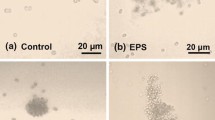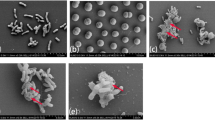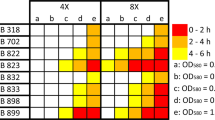Abstract
Colonial aggregation of Microcystis plays a key role in bloom formation. Limited studies have been reported about effects of environmental factors on the aggregation of Microcystis. Calcium is an important chemical element in water system. In this study, we investigated the effects of a low- (0.015 g l−1) and a high-concentration of calcium (0.100 g l−1) on the aggregation and buoyancy of a colonial strain M. aeruginosa XW01. Results show that compared to the low concentration of calcium, the high-calcium condition results in bigger colonial size, higher level of buoyancy and increased production of extracellular polysaccharides (EPS) of M. aeruginosa XW01. Increased production of EPS induced by the high-calcium concentration should contribute to the colonial aggregation and buoyancy of M. aeruginosa XW01. These results suggest that an increase in calcium concentration may be beneficial for Microcystis blooms occurring in a soft water lake.





Similar content being viewed by others
References
Bittencourt-Oliveira MC (2003) Detection of potential microcystin-producing cyanobacteria in Brazilian reservoirs with a mcyB molecular marker. Harmful Algae 2:51–60
Bradford MM (1976) A rapid and sensitive method for the quantitation of microgram quantities of protein utilizing the principle of protein-dye binding. Anal Biochem 72:248–254
Brookes J, Ganf GG (2001) Variations in the buoyancy response of Microcystis aeruginosa to nitrogen, phosphorus and light. J Plankton Res 23:1399–1411
Carmichael WW (1994) The toxins of cyanobacteria. Sci Am 270:78–86
Fulton RS, Paerl HW (1987) Effects of colonial morphology on zooplankton utilisation of algal resources during blue-green algal (Microcystis aeruginosa) blooms. Limnol Oceanogr 32:634–644
Jin XC, Liu HL, Tu QY, Zhang ZS, Zhu X (1990) Eutrophication of lakes in China. China Environmental Science Press, Beijing
Kim IS, Jang N (2006) The effect of calcium on the membrane biofouling in the membrane bioreactor (MBR). Water Res 40:2756–2764
Kehr JC, Zilliges Y, Springer A, Disney MD, Ratner DD, Bouchier C, Seeberger PH, Marsac NT, Dittmann E (2006) A mannan binding lectin is involved in cell–cell attachment in a toxic strain of Microcystis aeruginosa. Mol Microbiol 59:893–906
Lichtenthaler HK, Wellburn AR (1983) Determinations of total carotenoids and chlorophylls a and b of leaf extracts in different solvents. Biochem Soc Trans 603:591–592
Oliver RL, Ganf GG (2000) Freshwater blooms. In: Whitten BA, Potts M (eds) The ecology of cyanobacteria. Kluwer Acdemic Publishers, Netherlands, pp 149–194
Reynolds CS (2007) Variability in the provision and function of mucilage in phytoplankton: facultative responses to the environment. Hydrobiologia 578:3745–3768
Sakamoto S, Yamaguchi M, Watanabe MF, Watanabe M, Kamiya H (1996) Distribution and characterization of lectins from natural and cultured Microcystis spp. In: Yasumoto T, Oshima Y, Fukuyo Y (eds) Harmful and toxic algal blooms. Inter-Government Oceanographic Commission of UNESCO, Paris, pp 569–572
Su J, Jia S, Chen X, Yu H (2008) Morphology, cell growth, and polysaccharide production of Nostoc flagelliforme in liquid suspension culture at different agitation rates. J Appl Phycol 20:1573–5176
Waterbury JB (2006) The cyanobacteria—isolation, purification and identification. Prokaryotes 4:1053–1073
Widdel F (2007) Theory and measurement of bacterial growth. Online microbiology notes, http://www.mpi-bremen.de/Binaries/Binary5381/Wachstumsversuch(3).pdf
Wilson AE, Wilson WA, Hay ME (2006) Intraspecific variation in growth and morphology of the bloom-forming cyanobacterium Microcystis aeruginosa. Appl Environ Microbiol 11:7386–7389
Wilson AE, Kaul RB, Sarnelle O (2010) Growth rate consequences of coloniality in a harmful phytoplankter. PLoS One 5(1):e8679. doi:10.1371/journal.pone.0008679(pdf)
Ye HM, Yuan XY, Ge MX, Li JH, Sun H (2010) Water chemistry characteristics and controlling factors in the northern rivers in the Taihu Basin. Ecology and Environmental Sciences 19(1):23–27
Zhang M, Kong F, Tan X, Yang Z, Cao H, Xing P (2007) Biochemical, morphological, and genetic variations in Microcystis aeruginosa due to colony disaggregation. World J Microbiol Biotechnol 23:663–670
Acknowledgments
The project was sponsored by the Scientific Research Foundation for the Returned Overseas Chinese Scholars, State Education Ministry, and supported by Research Program of Jiangsu Province of China (NO. BS2007065).
Author information
Authors and Affiliations
Corresponding author
Rights and permissions
About this article
Cite this article
Wang, YW., Zhao, J., Li, JH. et al. Effects of Calcium Levels on Colonial Aggregation and Buoyancy of Microcystis aeruginosa . Curr Microbiol 62, 679–683 (2011). https://doi.org/10.1007/s00284-010-9762-7
Received:
Accepted:
Published:
Issue Date:
DOI: https://doi.org/10.1007/s00284-010-9762-7




